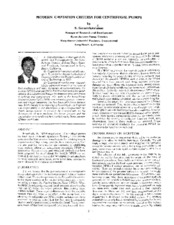| dc.description.abstract | It is well known that the performance of a rotordynamic pump deteriorates when the suction pressure is reduced below a certain value. The suction pressure is usually qualified in relation to the vapor pressure at the suction temperature and is represented by the term. Net Positive Suction Head (NPSH). When the NPSH is sufficiently reduced, local pressures at the impeller inlet can fall below the vapor pressure, thus causing vapor bubbles to form. These vapor volumes can block the available passage area and cause a reduction in the pump head and efficiency. At sufficiently low NPSH values, cavitation can have advanced to such an extent that the flow area is completely blocked and the pump is unable to develop head. This performance break-off has been recognized for a long time and, therefore, specifications are established to ensure that the pump can operate satisfactorily (meaning without break-off) at the values of NPSH available at the site. Typically, the specification is stated in terms of the NPSH needed to prevent a degradation in head greater than a specified value. A value of three percent is very common. This NPSH requirement has been found to be satisfactorily in a majority of pump installations. Recently, however, the trend towards increasing the power density of pumps has shown that even when the available NPSH is well in excess of the NPSH required for a three percent head drop, significant cavitation damage can occur. Along with increases in the running speed, operation at off-design conditions has been found to exacerbate this problem. Evidently under such circumstances, NPSH specifications based only on head degradation are unsatisfactory. Both the pump manufacturer and the user are interested in establishing more realistic cavitation criteria to ensure long life. Some of the criteria that have been proposed for different services are reviewed. They go from the extreme of no visible cavitation for very severe service to a small margin over break-off for light duties with fluid properties also considered. In some cases, cavitation criteria are specified in terms of suction specific speed. More recently, experimental work has been undertaken to establish the severity of cavitation based on short term observations. Some of these methods are reviewed. Some remarks on empirical methods for predicting NPSH requirements for long life are included. | en |


